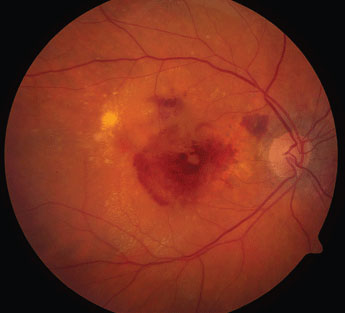 |
| Nearly one in four nAMD patients in this study had at least one delayed follow-up. Photo: NEI. Click image to enlarge. |
In a recent study, researchers reported that Canadian patients with universal health coverage experience relatively low rates of delayed follow-up visits for age-related macular degeneration (AMD), though the delays that did occur resulted in significant visual acuity decreases.
The retrospective study included all 1,291 neovascular AMD patients treated with anti-VEGF injections at two centers in Quebec over a period of eight years. All healthcare costs to the patient were covered by the government under universal health coverage. The authors defined delayed follow-up as a delay ≥four weeks than scheduled.
A total of 351 (27%) patients experienced at least one delayed follow-up. The authors reported that the odds of delay were significantly greater among patients treated at the hospital than at the clinic and among patients with worse initial visual acuity.
Overall, delayed follow-up was associated with a mean visual acuity loss of 4.2 letters and increased incidences of intraretinal and subretinal fluid at six months, despite resuming injections. Patients’ central foveal thickness increased after delays but returned to pre-delay visit thickness at six months. The authors identified intraretinal fluid before delayed follow-up as a risk factor (≥15 letter loss). Subretinal fluid, on the other hand, could be protective, they said.
“Most prior studies have defined lost-to-follow-up (LTFU) periods as six to 12 months without intravitreal injection, though shorter but clinically significant delayed follow-up visits are more frequent,” the authors wrote, explaining the rationale for their four-week delay period.
Additionally, they pointed out that while previous studies have taken age, race, income, distance traveled and disease laterality into consideration, they haven’t considered patients’ health insurance status. “Depending on definitions, studies in countries without universal health insurance reported rates of 22.2% (LTFU defined as >12 months) with no subsequent follow-up in 92.6% of patients, 32.2% (LTFU >56 days) and 57% after a first intravitreal injection,” they wrote. “With free universal health insurance, [a 2019 study reported] a very low rate (2.9%) of LTFU (>six months without intravitreal injection) likely due to health insurance.” The authors added that universal health insurance in their study likely mitigated increases in delayed follow-up during the pandemic.
“Measures should be implemented to reduce delayed follow-up to preserve visual acuity,” they concluded. “Though various treatment protocols may mitigate treatment burden, this study still highlights the prevalence and impact of suboptimal adherence.”
Rozon J, Hébert M, Laverdière C, et al. Delayed follow-up in patients with neovascular age-related macular degeneration treated under universal health coverage: risk factors and visual outcomes. Retina. April 26, 2022. [Epub ahead of print]. |

